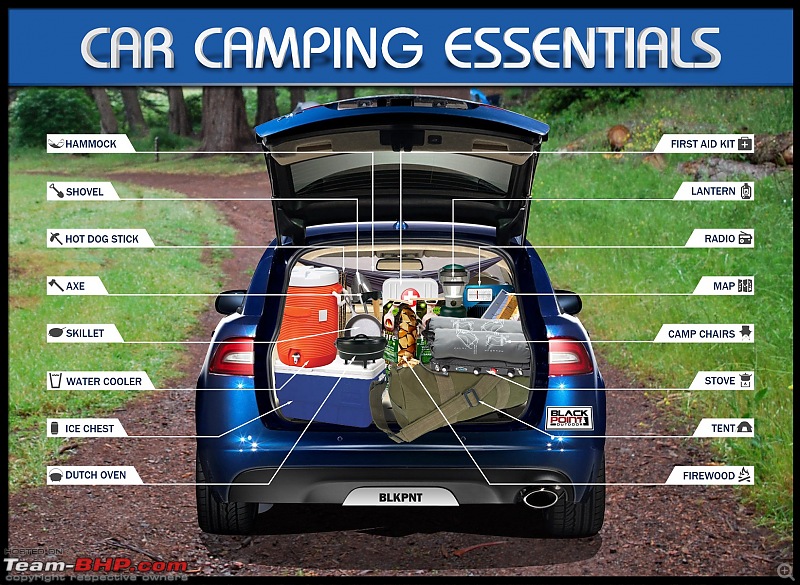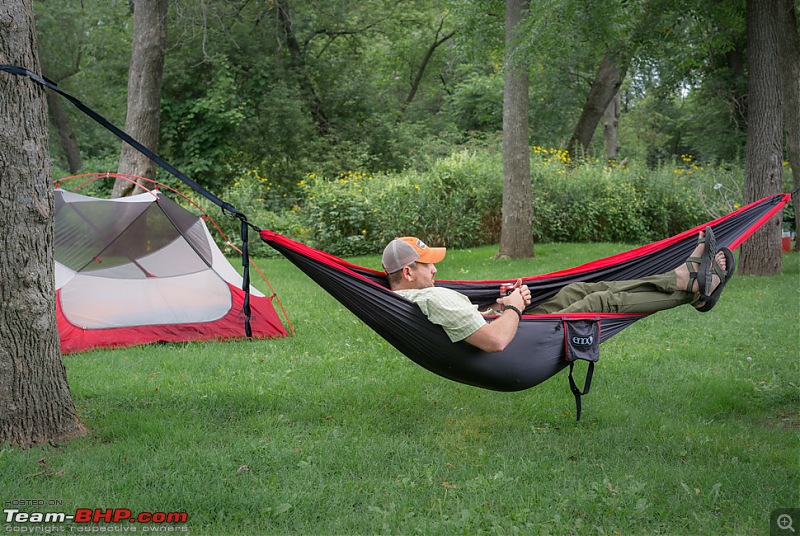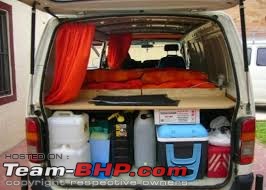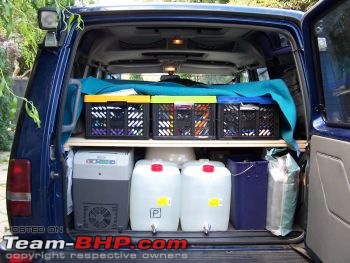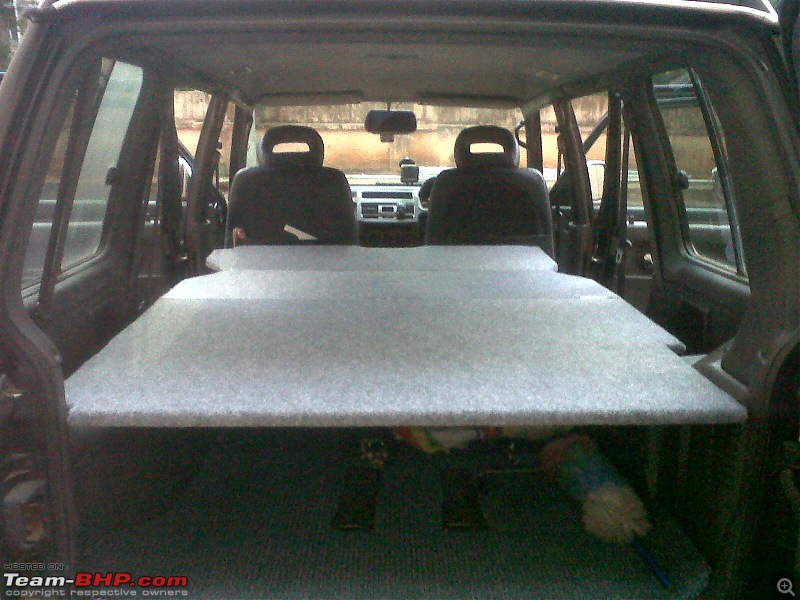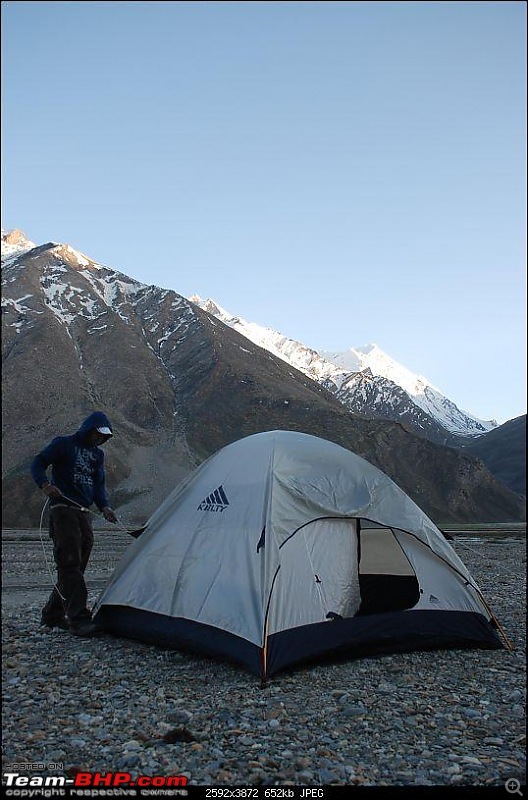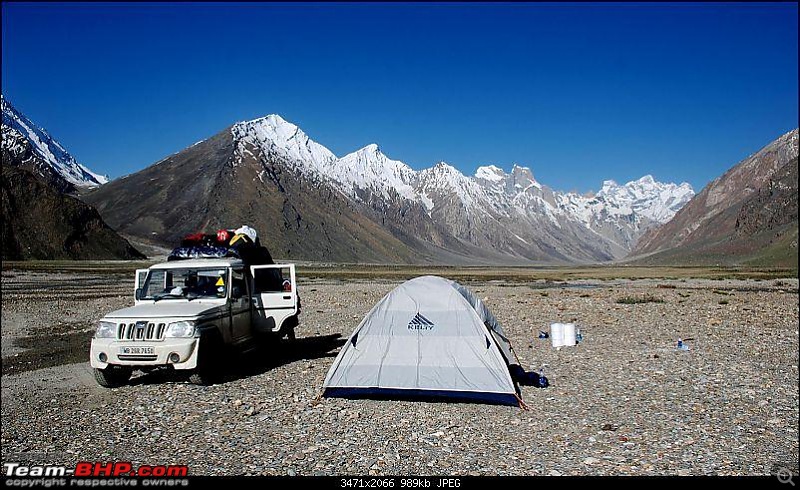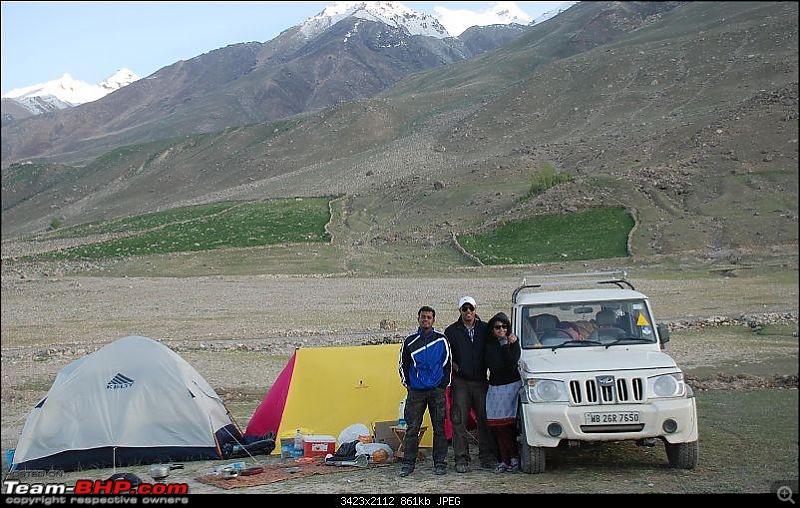Quote:
Originally Posted by BlackPearl  Excellent thread Unavowed_X9. I am a big fan of camping but have done it just twice till date in India.
....
|
Wow.
Excellent pics. I really admire the way you travel. Passionate as I can say.
I have read many of your travelogues and pretty impressed! Keep driving and keep exploring. Would be privileged to join you for a drive some time.
Regarding your queries:
1. I have a Coleman dual fuel stove that runs on unleaded petrol. It is getting extremely difficult nowadays to get loose petrol from the pumps. However even if I get hold of a litre or two, how safe is it to carry petrol in plastic bottles over long distances. What precautions can one take?
Though carrying flamable / explosive fluids is not legal, I am sure everyone agrees there are certain situations that require it to be done. As long as one can carry it safely, without discomfort to the occupants with the fumes leaking into the passenger compartment and considering the risk in case of a spark in circuitry. I would recommend fuel to be carried in metal jerry cans or in the worst case scenario use sturdy plastic cans safely secured on the roof rack.
In this regard, we may refer to the Petroleum Ministry's regulations.
Many countries have similar regulations too.
2. I have seen people carry gas stoves to camping sites. How safe is it to carry small gas cylinders in a vehicle over a long distance?
Same goes to the LPG cylinders. I would carry it on the roof after buffering it inside a wooden case with adequate padding inside which enables protection.
As per the list of items you mentioned, yes, I completely agree.
1. I already have an unfolding bed installed in the vehicle. For camping outside the vehicle in the tents, one may use either hammocks or sleeping mats that are standardly used by trekkers and mountaineers.
2. The inflator I carry is primarily for tyre inflation only.
3. Head torch is one thing I donot have as of now, and I am looking for a good deal on a couple of them. However, the pentorch can easily be used by strapping it to the peak of your cap with a fastener. I do carry an emergency lantern that can be charged through the USB / Power socket in the vehicle.
4. Salt for leech in case one is camping in the hills will be available from the cooking kit one would carry. Chloroquine as well as water purifying tablets in case you have to visit malaria prone areas. A mosquito net proves invaluable.
5. Foldable chairs or camp stools.
6. Hammer and shovel
7. Bug spray
8. Large carry bags or Large bins to carry the trash back
9. Pair of handheld CB radios (since the CB is delicensed and is legal now)
10. Mudplanks and other eqpt for recovery.
11. Updated GPS maps as well as toposheets of the areas if available with the Survey of India for reference.
Will add some more items to the list depending on the kind of drive one would undertake.
Warm regards.
Unavowed_X9
Quote:
Originally Posted by GTO  Lots of related threads on camping 
..... |
GTO, apt.
Yes, I read through all the links you mentioned. Realised it would be even great if all those locations were properly geotagged / logged to a single place to provide prompt information to aid planning?
Your car is basically an extension of yourself, and as such, camping along with it gives the trip a whole new different meaning and indulgence.
However, what surprised me was that many of the trips were old! Why am I finding fewer and latest such activities? Am I missing anything here?
The latest I see is @blackpearl's trip.
I believe in the economy of the activity so that everyone can have the budget to indulge in this really cool activity. Instead of spending a bomb on making expensive mods to the vehicles, some simple DIYs can really make the thing work!
Hope the great activity gets going sooner in a bigger way. No better way to explore nature along when you want to do it with your vehicle.
Warm regards.
Unavowed_X9
Quote:
Originally Posted by BlackPearl  Excellent thread Unavowed_X9. I am a big fan of camping but have done it just twice till date in India.
I have few queries regarding the stoves -
1. I have a Coleman dual fuel stove that runs on unleaded petrol. It is getting extremely difficult nowadays to get loose petrol from the pumps. However even if I get hold of a litre or two, how safe is it to carry petrol in plastic bottles over long distances. What precautions can one take?
2. I have seen people carry gas stoves to camping sites. How safe is it to carry small gas cylinders in a vehicle over a long distance?
...... |
As an afterthought, I searched for some data on legal carriage of fuel in vehicles. Please find some info in the following links.
1.
http://www.bbc.co.uk/newsbeat/articl...y-store-petrol
2.
http://www.whatsupdownunder.com.au/N...-February-2015
The above link (2) is from an Australian source of info normally adhered to while in the outback.
An extract from the same,
"Where to carry it?
This is a good question. Fuel Containers should be well secured and carried externally on your vehicle. It is not safe to store the containers inside a vehicle where the vapours can be inhaled. This can cause nausea, drowsiness or even be fatal as the fumes are poisonous.
But, you are very limited as to where you can safely carry them externally too. The fuel containers must not overhang your vehicle to either side (left or right). Must not be mounted on the front of your vehicle and if mounted on the rear of your vehicle it must be mounted in an approved holder (ADR compliant). If they appear to be mounted in an unsafe manner or they overhang the rear of the vehicle too much (determined by a Police Office or Road Safety Office) then an infringement can be issued. Another reason how the law is considered a 'grey area' as it may be left up to an authority to make a decision at any point in time.
You can carry extra fuel in approved containers in a secure roof basket if no other suitable option is available. It is crucial that they are secured well and strapped in so they can not slide. You do need to keep the weight in mind when adding items to your roof. Each 20l fuel container adds around 23kgs when full so this will change your vehicles centre of gravity and you need to be aware not to exceed your basket's/roof rack's weight ratings.
You must not carry more than a total of 250 litres of fuel on/in your vehicle at any one time (including the contents of your standard fuel tanks).
Carrying fuel containers on the rear of caravans or on the drawbar of trailers is not advisable. This is because fuel can ignite on impact and these areas are most prone to collision. However, I was not able to get a definite answer regarding legality of this except that they must be securely mounted.
This is NOT legal advice by any means. Give your insurance company a call and ask them if they have any restrictions on fuel container placement. Best to get any advice of that nature in writing for reference if ever needed later on."
3.
http://www.hse.gov.uk/cdg/manual/com...ems/petrol.htm
Though the above link (3) is from UK, common laws would accept a UN standard, and as such, the below can hold good in terms of legal issues.
An extract from the page,
"Up to 1 litre of petrol can be carried under the LQ provisions (see Main Exemptions).
As a "small load"
The small load exemptions (Main Exemptions) will be applicable up to a total quantity of 333 litres (if other dangerous goods are carried the aggregation rules must be applied). The containers must be UN approved (see Packaging) and properly labelled (see Consignment Procedures). Typical 5 litre containers purchased from car accessory shops and garages may not be so approved.
A typical case would be the carriage of two or three jerricans in a van. Providing those cans are UN approved, marked UN 1203 and labelled with the flammable diamond, the only requirements are
Driver training in accordance with ADR 1.3
Carry 2 kg fire extinguisher
Stow the jerry cans correctly to avoid damage or loss from the vehicle
Note: a typical steel jerry can might be marked un 3A1/Y/170/**/GB/****
** is the year of manufacture and **** the packaging certificate number.
In this case no density figure is give after the "Y" which means it is suitable only for liquids with relative density ≤ 1.2 (petrol is typically 0.8 or less)"
Warm regards.
Unavowed_X9
 (16)
Thanks
(16)
Thanks
 (2)
Thanks
(2)
Thanks
 (2)
Thanks
(2)
Thanks
 (1)
Thanks
(1)
Thanks

 (5)
Thanks
(5)
Thanks

 (1)
Thanks
(1)
Thanks

 (6)
Thanks
(6)
Thanks
 (3)
Thanks
(3)
Thanks
 (1)
Thanks
(1)
Thanks
 (1)
Thanks
(1)
Thanks
 (1)
Thanks
(1)
Thanks
 (2)
Thanks
(2)
Thanks
 (3)
Thanks
(3)
Thanks




